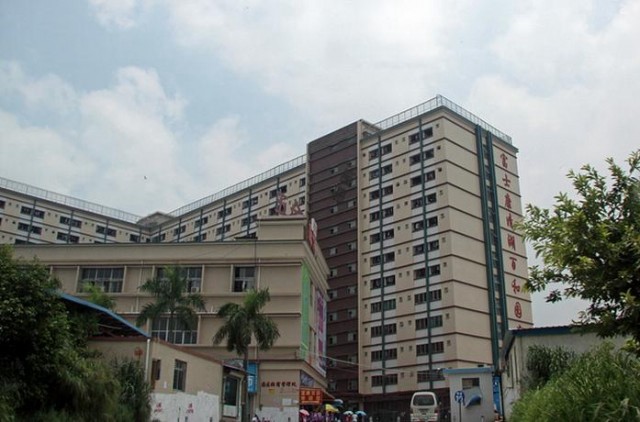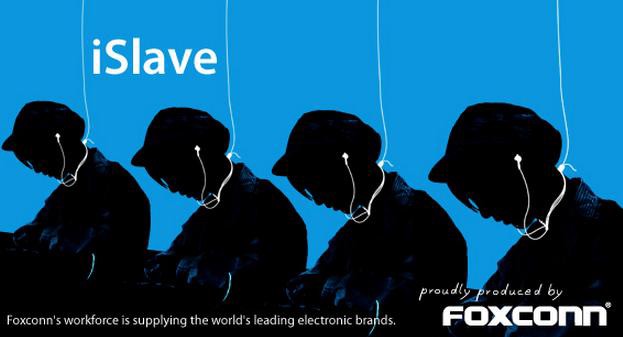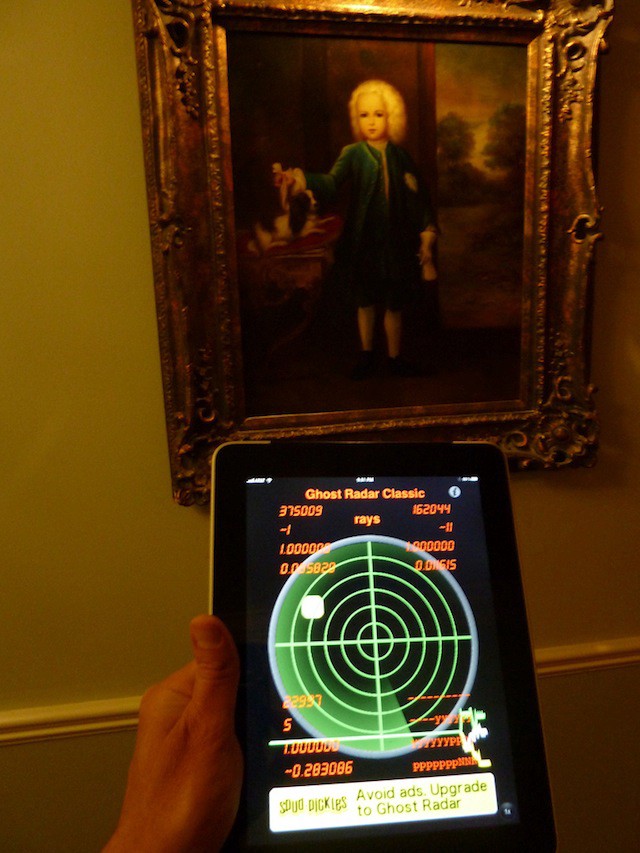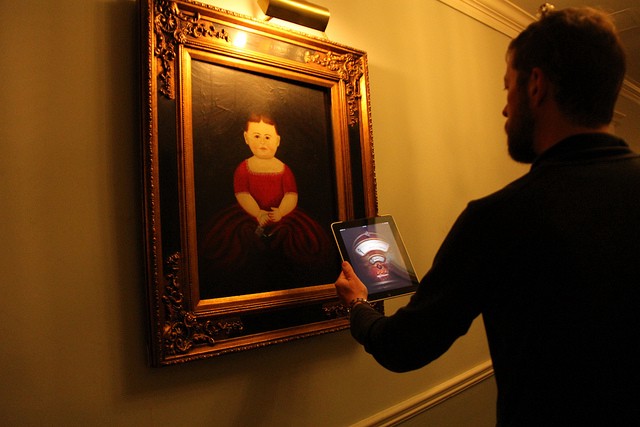The Foxconn Economy: From the State Dept. to China to Your Slideshow Pageviews
by Abe Sauer

In 2009, 17-year-old Liu Pan was working at the Yiuwah Stationary Factory, in Dongguan, China, operating an antiquated machine that crushed paper. Yiuwah manufactured goods for companies like Disney and Coca-Cola. When Liu Pan was killed by the machine he operated, China Labor Watch released a report about his death. David Barboza, the Shanghai-based Times correspondent, ran with the Liu Pan report, noting that the teen had been hired illegally at 15. Disney was quickly on its heels, facing a PR nightmare.
But Disney caught a huge break. A 25-year-old man, Sun Danyong, who had been questioned about a lost iPhone prototype at the factory where he worked, leaped to his death from the 12th floor of his apartment building. The Times gave credit to China Labor Watch for its previous report on this factory, which had a name fit for Hollywood villainy: Foxconn.
Earlier this month, China Labor Watch issued a media alert announcing that a Foxconn iPhone 5 plant had been paralyzed by a massive strike. The report was picked up by Reuters, and every blog in the world. Apple stock fell more than 2 percent.
Now it appears that the strike report was a sensational, questionably-sourced story about a manufacturer that has become the bogeyman for China’s labor conditions.
Over the last few years, Foxconn has become a meal ticket for China Labor Watch and organizations like it. Its reports, in turn, are a page-view goldmine for a myopic media. Along the way, Foxconn has become a means for self-loathing Apple owners to flagellate themselves — and maybe even a knife the U.S. government can twist to destabilize the Chinese Communist Party.
***
It’s unclear what happened at the Foxconn factory in Zhengzhou. Initial media reports all relayed CLW’s statement of “a large-scale strike” involving “three to four thousand production workers.” Distinguishing itself for special merit was Business Insider, which teed off on CLW’s press release with a photo of a Chinese mob marching in unison. (That “angry mob” was actually a celebratory parade at Chimei Innolux; they make LCD screens.)
A day later, Foxconn officials said the work stoppage was confined to a few hundred quality inspectors and lasted only an hour or two. A day after running the major strike story, the same media could be found running Foxconn’s denial.
On October 6th, 7th and 8th, China Labor Watch quietly updated its initial story online. They included a note that the workers were paid three times normal salary for working the holiday — having to work on the holiday was originally an impetus for the “strike,” and China Labor Watch said that the workers were “not permitted to have a vacation during the holiday.”
Then, Bloomberg’s Shanghai-based reporter Adam Minter found a Weibo post from an anonymous user with the handle “Ye Fudao” (野夫刀). In rigorous detail, Minter broke down the user’s history, noting that he appeared to be a labor activist with a long history of posting criticism of Foxconn. Minter also pointed out that after the news hit, Ye Fudao criticized news reports — which were all based on CLW’s alert — as “exaggerated.”
During an email conversation over several days, one that wobbled back and forth between English and Chinese, I asked China Labor Watch founder Li Qiang about that Weibo user. He write that Ye Fudao was one of his primary sources, and that he had used him as a source numerous times for information and confirmations about goings on at Foxconn (“帮助过我们的调查,多次找他确认信息… 我有询问他多次关于富士康的情况”). I asked if Ye was a labor activist. Li avoided the question, saying he was “a worker.” I asked if Li knew the name of one of his most valuable Foxconn sources. Li said that he did not.
***

Shenzhen, Guangdong.
China Labor Watch, founded in 2000, had for years been warning about the working conditions of young Chinese workers. It immediately began getting attention; its first reference in the New York Times came that year.
For its first nine years, China Labor Watch did not focus at all on Apple. For example, in its 2008 report on the manufacturer, it notes that Foxconn’s “primary clients are Lenovo, Nintendo, Sony, and Philip [sic].” The only mention of Apple in that report is the criticism that, at Foxconn, “only workers producing merchandises for Apple are offered a stool to sit while working.”
China Labor Watch’s lack of attention to Foxconn shouldn’t be a surprise given that the organization and its founder believe that the company is one of China’s most exemplary workplaces — at least, in comparison to others. In a Q&A; with The New York Times’ The Lede blog back in January, Li said, “Foxconn is not good. But if we compare all industries, electronics, textile, toys, Foxconn is one of the best.”
In a very diplomatic open letter to Apple CEO Tim Cook just weeks after that interview, Li wrote, “I find that the labor conditions in Apple’s Chinese supplier factories are actually not the worst of the factories used by multinational electronics companies there” and that “to be fair, Apple’s problems are not unique.”
China Labor Watch’s own research bears this out. In a comprehensive report from June, 2012, titled “Beyond Foxconn: Deplorable Working Conditions Characterize Apple’s Entire Supply Chain,” China Labor Watch found Foxconn workers reported the highest average hourly wage and the lowest total hours worked on average. To the question of “How much does the working environment affect your health,” Foxconn respondents, by far, were less likely to answer that the impact was “Fairly large” or “large.”
In a press release about the study, China Labor Watch announced, “In most factories, workers generally work 11 hours every day….” Foxconn workers were found to average 9.98 hours of work per day.
That same report concludes:” working conditions at Foxconn’s Apple factory in Shenzhen, as bad as they are, are nonetheless better than working conditions found in Apple supplier Riteng’s three factories in Shanghai.”
I asked why Foxconn’s comparatively good working conditions are rarely the focus of media reports (if they’re mentioned at all). “I don’t know the reason that media reports doesn’t state that Foxconn is the best as compared to other electronic factories,” Li told me. “You can see that we always emphasize this point in our report.”
***
When the recent “strike” story hit, the media’s Foxconn frenzy was already high. There had been a riot at another Foxconn factory, in Taiyuan, the month before. At that location, a few thousand workers damaged cars and scooters and brawled after some kind of disagreement. Some reported that a security guard had beaten a worker. Others reported that drunk workers from separate provinces had started a fight.
But the media assumed that this massive brawl should have a deeper meaning. For support, it looked to the existing stockpile of suicides and explosions laid out in reports by groups like China Labor Watch. With little evidence, the AP reported that the riot “highlighted tensions that labor groups say were worsened by the pressure of a new iPhone launch.” In a piece titled “Riot at Foxconn Factory Underscores Rift in China,” The New York Times, sourcing an NGO called China Labor Bulletin, noted that the “unrest was noteworthy because the factory site is managed by Foxconn Technology.” The same Times article allowed that “the cause of the latest dispute in Taiyuan remained unclear,” but did not stop it from it from speculating about the cause, making sure to slip in two mentions of the iPhone 5. Evan Osnos’ New Yorker piece urging perspective and sobriety about the riot and Apple’s role was ridiculously headlined “What the Foxconn Riot Says About China.” The piece’s URL title, used for Google search results, was: “What the Foxconn Riot Says About China and Apple.” And its URL was just an SEO chain: “foxconn-riot-apple-china.html.”
China Labor Watch spokesman Kevin Slaten told Mother Jones, “This is not something that just happens at any factory in China….The stress in a lot of factories — especially when they are producing iPhone 5 and new products — is extremely high.”
But actually, it is something that “just happens” at any factory in China. In fact, anywhere in China at all. It’s certainly possible that iPhone 5 production pressures and labor conditions caused the massive brawl. It’s just as likely, maybe more so, that being in China caused a massive brawl. As The New York Times itself reminded us just last year: China is just a brawling kind of place. Just days after the “riot” at Taiyuan, a hospital in Dongguan experienced a brawl “involving around 2,000 people.” The hospital was not involved in iPhone production.
When a massive brawl at a factory in southern China left one dead in 2009, ethnic clashes, not labor conditions, were the cause. But because the factory may have been making the iPhone, initial reports that the Taiyuan Foxconn riot was caused by provincial rivalries were dismissed for the more popular, more iPhone-5y narrative.
Proving just how much China Labor Watch’s own narrative has changed, Slaten’s statement that the Foxconn brawl was “not something that just happens at any factory in China” forgets the thousand-person riot at a Dongguan toy factory in 2006 — a riot that was brought to international attention by a China Labor Watch media alert. That factory supplied toys for Disney.
***

A nominee for the 2011 Public Eye Awards.
It’s easy to see the trap China Labor Watch has fallen into. After slogging away for the better part of the decade receiving respectable yet meager media attention, along came the headline-friendly Apple suicides narrative and a subsequent flood of attention to them and their cause. Its founder, Li, became a marquee source for papers like The New York Times.
When Foxconn and Apple became a hot editorial commodity in 2010 — Mike Daisey’s “The Agony and Ecstasy of Steve Jobs” debuted that year — The Times’ David Barboza used China Labor Watch as a source three times in three different stories between May 21st and June 6th. All three stories portrayed Foxconn negatively.
And then on June 25, the Consumed column of the New York Times Magazine used China Labor Watch again as a source for a piece on Foxconn. The author wrote, “The point here is not to demonize foreign manufacturing in general or Foxconn in particular, but to ask some questions….” But the demonization had already begun.
Those 2010 stories were about several suicides that had occurred at Foxconn facilities, events that set the tone for Foxconn coverage ever since. What we have been told to understand is that Foxconn isn’t just a typically bad (in fact, far better than average) Chinese workplace, it’s a kill-yourself-bad workplace. This narrative has taken hold despite the fact that the suicide rate of workers at Foxconn falls well below the national average — a point some journalists at the time pointed out.
China’s social networks are filled with stories of suicide. Jumping off buildings is especially popular, perhaps because nobody has a gun. In August, Sina even put together a helpful gallery of a few of the most spectacular attempts. (Take that, Buzzfeed and Business Insider.) Like in, say, every other country in the world, rationale for suicide vary from the tragically severe to the mindbogglingly trite; More than one teenager has killed herself recently supposedly because her school made her cut her hair.
Two years later, despite measurable improvements in its factories (and the promise of more to come), the Foxconn narrative chugs along its set course. The New York Times’ published two major pieces in September outlining the bad working conditions at Foxconn. One used China Labor Watch as a source; the second used China Labor Bulletin.
In 2011, as the Apple-Foxconn narrative gained steam, China Labor Watch issued multiple reports on subjects like child labor at factories supplying Target, suicides at Mattel suppliers, and an employee making Timberland boots who dropped dead of illness on the line after his request for time off was refused. Unable to find many, if any, press mentions of these reports, I asked Li if he remembers CLW getting any media attention for them. “No, I don’t think so,” he said. “I remembered that the Wall Street Journal has quoted Mattel’s report. The others, I can’t be sure.”
China Labor Watch’s strategy is now focused on pounding Apple with bad PR in the hopes that the company will then pressure changes at Foxconn, setting the bar for other companies to follow. Li defended this rising-tide-all-boats approach. “I think that the change of the work conditions in Foxconn will set up a new and better standard for all electronic factories in China,” he wrote to me. Last time Foxconn raised the salary of their workers, he wrote, this had an effect on “the whole electronic field.”
“We focus on them because to go after every little company in the electronics industry would be impractical,” China Labor Watch’s spokesman Slaten wrote. “Rather, by influencing Foxconn and Apple to improve, we can support the movement to change the labor conditions in the entire electronics industry.”
If that bad press doesn’t come fast, or hard enough, it appears China Labor Watch is willing to create it.
In addition to questions about the legitimacy of its primary source, China Labor Watch’s October 7th update to its original report on the “paralyzing” strike massaged the organization’s original contention that it had involved “thousands” of workers.
According to the information provided to us by 3 workers at Foxconn Zhengzhou. On October 5th, at the beginning, over 300 quality inspectors refused to swipe their cards and go to work in the morning. Later on, quality inspectors from 3 branch factories start to participate in the strike. The workers told us that there are around 100 quality inspectors per production workshop, and more than 70 production workshops were involved.
Not only did the report’s sources change from “workers” to “3 workers,” but also the 3,000 to 4,000 number turns out to be an extrapolation from what those three workers experienced in their section of a factory — a factory the size of Glendale, California.
Li is based in the U.S., where finding out exactly what is going on inside China is an even bigger challenge than the already challenging job of finding out exactly what’s going on inside China from inside China. So it’s no surprise that China Labor Watch, like everyone who reports on China, relies on Weibo. During the latest Foxconn “strike,” it appears this tendency to connect the lines between small Weibo dots got the best of them.
In defense of their strike report, Slaten wrote, “First, our update was information gathered after the initial statement. To leave out details, we would have had to have the details in the first place. We did not. Therefore, your accusation seems baseless.”
***
China Labor Watch is not the only source for the press to turn to when it wants to add credence to its Apple labor woes reports. China Labor Bulletin also puts out a wealth of valuable information on all kinds of other horrendous labor conditions, but it too has recently found itself sucked into the Foxconnomy.
For example, a September 26th Bloomberg piece titled “Foxconn Workers Labor Under Guard After Riot Shuts Plant” quotes China Labor Bulletin. A Bloomberg story a few days later, titled “Foxconn Labor Disputes Disrupt IPhone Output for 2nd Time” (by the same authors), again quotes China Labor Bulletin’s director. In between those two stories, China Labor Bulletin was quoted in a Bloomberg Businessweek piece: “What’s Behind the Foxconn Worker Riots?” An AP piece headlined “Apple Supplier’s Factory Back Up After China Brawl” sourced the speculation of labor unrest to both China Labor Watch and China Labor Bulletin.
In their numerous citations in the press, China Labor Watch and China Labor Bulletin are never identified beyond, respectively, “a nonprofit group in New York City” and “a nonprofit group in Hong Kong.”
Nearly half of China Labor Watch’s funding comes from the National Endowment for Democracy (NED), a nonprofit grant-making institution that is funded as a line item of the U.S. Agency for International Development, which reports to the State Department. NED dedicated to “supporting freedom around the world.” Li told me that the $90,000 it received from NED — an increase over the $34,070 in 2009 — is for the expansion of a project from 2008 and “has nothing to do with Apple or any of its suppliers.”
The China Labor Bulletin has also been funded, in part, by NED. China Labor Bulletin’s founder, Han Dongfang, is a Tiananmen Square protest exile and democracy activist. In 2008, Han joined a NED roundtable called “Law, Rights and Democracy in China” alongside a who’s who of anti-Chinese Communist Party activists, including fellow exiled Tiananmen Square demonstrator Yang Jianli and China Aid Association funder and perpetual thorn in Beijing’s side, Bob Fu.
NED does, in the open, the “hearts and minds” work that the CIA once did in secret. NED funds a dozen or so China operations whose aim is to promote democracy in China and destabilize the ruling communist party. This connection certainly does not help when it comes to operating inside China, something China Labor Watch told me has become especially traumatic. Authorities recently tried to close their offices in Suzhou and Shenzhen. (I reached out to NED’s press liaison and never heard back.)
That CLW and CLB share a patron should at least raise serious questions for any media organization that regularly uses either, or more likely both, as a source about Apple’s China operations.
***

Don Cochrane’s “Send Two Dollars to Apple” campaign was published in YES! magazine in May, 2012.
It’s likely that China Labor Watch is a good faith actor addicted to the juice of the media’s thriving Foxconnomy. What they learned is that poking Apple in the eye with the Foxconn stick is worth a boatload of page views, along with more visibility for the activist organization that feeds the narrative. Despite the thousands of possible targets, Li told me that China Labor Watch was “planning to do an investigation on another Apple supplier factories.”
To get a general sense of how big the media Foxconnomy is, one can look at Gawker Media tech blog Gizmodo, which handily lists traffic numbers next to stories. For just the entries tagged “Foxconn” over the last six months, Gizmodo has collected roughly a million pageviews. Keep in mind that none of that is original reporting on Foxconn — back in 2010, there were also plenty for Joel Johnson’s Wired-sponsored trip to the Foxconn factory in Shenzhen — but instead blog posts about other reports on Foxconn. Most of which were sourced back to China Labor Watch.
A distinguishing detail of the media Foxconnomy is that there is almost as much to be gained from getting it wrong as getting it right. For example, on October 5th, Gizmodo ran the China Labor Watch report with the headline “Foxconn Workers on Strike After iPhone 5 Starts Brawls.” Total: 141,329 . Eighteen hours later, Gizmodo posted “Foxconn Denies Strikes, Says Everything Is Going Just Fine” and racked up another 14,858.
Probably the best possible example of this dynamic at work happened with Mike Daisey, the playwright exposed in March as having fudged significant portions of his Apple- and Foxconn-condemning play “The Agony and Ecstasy of Steve Jobs,” after it was broadcast as a story on “This American Life.”
After “This American Life” did an entire episode retracting the piece, Daisey wrote in his defense, “[The monologue] uses a combination of fact, memoir, and dramatic license to tell its story, and I believe it does so with integrity. Certainly, the comprehensive investigations undertaken by the New York Times and a number of labor rights groups to document conditions in electronics manufacturing would seem to bear this out.”
Not just investigations. In 2011, Mike Daisey wrote an op-ed for the Times. Later, the Times withdrew a chunk of the piece, running a retraction that said “Questions have been raised about the truth of a paragraph in the original version of this article that purported to talk about conditions at Apple’s factory in China.”
Now, Mike Daisey has just released “The Agony and Ecstasy of Steve Jobs 2.0.”
Despite Daisey billing it as “ethically made,” the 2.0 version of the show still contains discrepancies, many admittedly small, between Daisey’s version of events and his translator’s. About these, Daisey told me, “I’m confident that any differences that remain in the show between what she remembers and I remember are just that: two different memories of the same event. I took out anything that felt majorly dissonant, but any time two people share the same experience they’re going to have different versions of the same event. Just ask my wife.”
To complete the circle of the Foxconnomy, and despite the embarrassment of having to excise portions of his op-ed from its own paper due to falsehoods, The New York Times’s review of the 2.0 version of Daisey’s Foxconn monologue said that the show was “if anything more powerful, funny and engaging than the earlier production.” Daisey immediately reproduced that quote on his website as an endorsement from The New York Times. Circle, complete.
But then, the paper might not be the right organization to take Daisey to task for his Apple bashing. Three days after publishing a September 9th, 2012, piece headlined “China Contractor Again Faces Labor Issue on iPhones,” The Times issued the following correction:
An article on Tuesday about new labor issues at Foxconn, a Chinese factory that makes Apple products, misstated the number of explosions that have occurred at the company’s plants. Only one explosion has occurred at a Foxconn plant, not “several.”
Everyone gets a bite of the Apple Foxconnomy. As The New York Times said of Daisey’s new 2.0, believe-me-this-time version of his show, even the theater found a way to get a piece: “In fact the company, far from fleeing the scandal, used it as a promotional tool: ads for the return engagement referred to it as ‘the most notorious and controversial play of the decade.’”
In the end, Daisey and China Labor Watch are similar creatures. In his open letter to CEO Tim Cook, Li outed himself, like Daisey, as an iPhone-owning Apple fanboy who is simply disappointed with Apple’s labor record. The two are also alike in that they see the ends as a justification of the means.
Li insisted that I include the following in any report about China Labor Watch. “In 2006, 300 workers in Foxconn live in the same dormitory. Now 8 workers live in the same dormitory. There are also many other improvements. If there were not these reports on the working conditions of the workers in Foxconn, there probably won’t be so any changes.”
I asked then if he thought there was a downside to the media’s obsession with Apple and Foxconn in China. Li told me, “I don’t see any down side effects.”
Abe Sauer is the author of the book How to be: North Dakota. Email him at abesauer AT gmail.com.
Top photo by Mattsches. Shenzhen photo by Yuan2003. “iSlave” photo by Greenpeace Switzerland. “Two dollars to Apple” by Don Cochrane.
Human Cadaver Recycling Plan Sounds Eerily Familiar

“Death will come for us all one day, but life will not fade from our bodies all at once. After our lungs stop breathing, our hearts stop beating, our minds stop racing, our bodies cool, and long after our vital signs cease, little pockets of cells can live for days, even weeks. Now scientists have harvested such cells from the scalps and brain linings of human corpses and reprogrammed them into stem cells. In other words, dead people can yield living cells that can be converted into any cell or tissue in the body.”
— All I can say about this is “Fire bad.”
"U.S. Venture" Remarkably American
“A U.S. venture plans to use a remote-controlled ‘stealth’ airship to hunt for signs of Bigfoot in the mountains of California.” There’s a video and stuff, but, you know what? You watch it. I’ve got better things to do, like mouth-breathing.
Creepy New Orleans Ghost Stories That Were A Lot Scarier At The Time

Part of a series about monsters and other scary things happening here through Halloween.
What makes for a very scary story? It helps to be a child when you’re hearing the tale, because you’re already terrified of everything after dark. It’s also a good idea to be at home alone while you’re reading, so that every burp of the water pipes or cough from the weird neighbor in the next apartment sounds like the foretelling of your horrifically slow murder at the hands of THE DERELICT CLOWN. This is due to the power of The Devil, who creates suspense.
Without suspense, the glaring holes in most ghost stories become apparent. This became clear to me recently when I tried and failed to scare the bejesus out of my young children with a very chilling “true story” my Cajun grandmother once told me and the neighbor kids. Her actual circumstances were already so awful that any hint of the supernatural was accepted, by my young mind, as just another chunk of impossibly sad luck: She and her half-dozen siblings were orphans, and lived without adult supervision in some crumbling bayou house far from the nearest town. (If I knew how to weave a weird but charming regional narrative out of this golden thread, an agent would tell me, “It’s an awful lot like Swamplandia! How about something in the snow, or a coming-of-age story with a Mexican family?”)
It was after supper one night when the Cajun orphans were gathered on the saggy wooden porch, listening to a battery-powered radio for entertainment. Imagine trying to listen — no seeing! — to a program or sports game without even being able to tweet about it. Even worse, a flickering light appeared in the upper window of the old barn on the property. And through the dangling Spanish moss and the fog of fear, the orphans saw the shadow of a diabolical winged entity through that barn window.
“It was an angel,” said my grandmother, who we all called Ma-De, believing it to be French for “grandmother.”
“Sounds a lot more like a devil,” I said. My best friend noted that it could have been Dracula.
“It was an angel,” she repeated sternly. I was used to angels being papier-mâché cherubs on Mardi Gras floats or cutesy paintings on Merry Go Rounds, but her angels were a more Old Testament affair, the kinds of powerful Olympians who wrestled you to the desert floor or fought you on ladders to Heaven or tricked you (?) into impregnating your wife in a shepherd’s tent. (OR, exactly like those evil “weeping angels” from the Doctor Who program. It would have been a lot better if the weeping angels just tore Amy and Rory to bits, wouldn’t it? STUPID STUPID LAST EPISODE. Anyway.)

I can still remember the gnawing terror from hearing my grandmother’s story, but I can’t remember why I felt it. The swamp orphans supposedly watched the shadowy figure all night, until it faded away in the first light of dawn. From her other stories of life on the bayou, I knew they had a small arsenal of shotguns and rifles and pistols and crab traps in that old house. That’s how they ate! Why didn’t the biggest kid, who was already 6’4″ in his teens, just load up on guns and shoot first and ask questions later. You know, like an American?
Why didn’t anyone think it was maybe a hobo of some kind? It was the Great Depression, after all. Would it not be “more realistic” if an itinerant worker with his railroad lantern spent the night in the barn’s loft, away from the many poisonous snakes that traveled the swampy ground? My own grandfather, who married the very woman who told this story, spent years during the Depression riding the rails of Texas and the southern states, working here and there, maybe at the circus or on a chain gang. So, I failed at re-telling this story, because in retrospect it was dumb.
This is what separates most writers from a yarn-spinning master like Stephen King. (I am also wealthier than Stephen King.) The scaremaster does not care if the story is dumb. Of course the story is dumb! If anybody really thinks about it, they know there’s not an Impossible Evil lurking in the sewers in the form of a clown. That’s really just Tim Curry, living in the sewers. Times are tough. That car isn’t possessed, it’s just a shitty car and teen-agers are bad drivers. The dead baby who crawled out of its makeshift grave is… well, that is awful, but only because Bush Junior didn’t let the children have health insurance. And also you don’t want a dead baby standing in your home office because you could lose your home office deduction!
Another questionably scary story involved my Uncle Tommy, a bus driver in New Orleans. If you’ve been there, I hope you spent a lot of money, and not at the Marriott or whatever corporate vulture tourist business! Also, you may have noticed there are cemeteries everywhere. Those weird above-ground graves and crypts (because of the sodden below-sea-level ground) make for lots of easy ghost stories. And people really love going to the cemeteries, so they can endlessly talk and weep and complain about their dead relatives, which is the only exercise most people in New Orleans will ever get.
Uncle Tommy was on the graveyard shift, and also driving the graveyard bus route. (Is there another city with a streetcar line named Cemeteries?) Around four in the morning, he saw a beautiful young woman standing unsteadily at the bus stop, which would suggest he was actually near Tulane. But he was at the cemetery, this is part of the story. So she got on the bus and asked if he’d take her not to another bus stop, but to her house in the Garden District, probably where Anne Rice lives now. And, because city employees do whatever they want in New Orleans, he drove the city bus to this spooky old mansion and knocked on the door and…

Of course you know the end, because every kid has heard some variation of this story, and also there is the Internet now, and the Urban Legends books and Twitter and all that. The father answers the door, probably in a smoking jacket, and says that his daughter died in a terrible accident (alligators?) years ago, but she still flags down buses and asks for a ride home now and then, because the rich are so entitled.
Let me tell you what works, if you want to terrify, say, your own impressionable children: Talk a lot about ghosts, at night, but in a postmodern “eh, maybe they’re real, maybe they’re not” kind of way, and then quietly hang a pillowcase or a sheet in a weird spot in the back room, and insist that they go in there “just to make sure” ghosts aren’t real. The shrieks are incredible.
Previously in series: We, The People, Against The Zombies
And you may also enjoy: “I Met A Ghost!” Five Chilling Real-Life Tales!
Photos from a recent stay at the Le Pavillion Hotel in New Orleans, which is supposedly haunted and also made my iPad ghost meter go nuts.
Do Not Stick The Following Things Into Your Ear
Things not to insert into your ear canal: ear spoons, picks, toy swords, bobby pins, and car keys. I imagine there are others, but this seems like a good start.
Keith Richards Demands Guarantee From God If The Stones Are To Play This Summer's Glastonbury...
Keith Richards Demands Guarantee From God If The Stones Are To Play This Summer’s Glastonbury Festival

“On a good day if the weather’s fine, that’s an interesting proposition.”
— The Rolling Stones have a new album coming out next month, have you heard? It’s called Grrr! , and its cover art is by far the best the band has released since at least 1983’s Undercover. It’s clean and arresting and kind of naughty and dangerous and inappropriate for a group of 70-year-old men — I like everything about it except for the finger-painting font they borrowed from Bruce Springsteen’s latest album cover. Unfortunately, upon the first few listens, new single “Doom and Gloom” (I know, I know: why even listen to a new Rolling Stones song in 2012? because I love them that’s why — no matter what, I love them and will always love them) has me pining for Undercover’s titular track, “Undercover of the Night.” Which, now that I’m listening to it, seems less sad than it might have 29 years ago. Listening to it now, “Undercover of the Night” sounds pretty great!
Curl up, baby! Curl up tight! I love that video, too.
Here’s the new one for “Doom and Gloom”:
It’s sort of like the Cee-Lo video from last year, but again, finger-painted by Bruce Springsteen.
Pretend To Be Republican If You Want To Snag A Beautiful Woman
“Does being beautiful on the outside make you beautiful on the inside? Not necessarily, although attractive women are often thought to have more desirable personality traits in the eyes of strangers, new research shows. In actuality, beautiful women might be more likely to have some less attractive values, favoring conformity and self-promotion over independence and tolerance, the study found.”
OMG, It's Curator Nicolaus Schafhausen!!!

Curating is so, so hot right now. Hence our weekly guide to curators! Collect them all! (Haha, GET IT?)
This week’s “OMG” curator of interest: Nicolaus Schafhausen.
Born in: 1965.
This just in: became artistic director of the Kunsthalle Wien in June. (That’s Vienna, silly!)
Hot news: also just appointed curator of the Bucharest Biennale 6!!!
Former posts: Director of Witte de With in Rotterdam, founding director of European Kunsthalle in Cologne.
Fancy gigs: Curated the German pavilion for both the 52nd and 53rd Venice Biennial.
Fun fact: Founded a gallery in Berlin with a friend that they named after their mothers!
Not afraid of: the commercial side of artistic practice, the alienation of modern life.
Killer quotes: “To modernism, abstraction meant an absolute belief in progress.”
Weirdest place worked: Nova Scotia!!!
Back in the day: Curated “a group show on the nebulous topic of nonplaces”!
Some of his faves: Adorno, Olafur Eliasson, Liam Gillick, Isa Genzken.
Single? He’s not telling!
Lost in translation: “Schaf Hausen” in German kind of means “Live Sheep” or “Sheep-Liver”!!!
Magazine Good
I gotta tell ya, I take an almost scary number of magazines each week — hahaha, now I’m an old Jew from the fifties… “I take the paper! I know what’s happening! Etc!” — and there is nothing I look forward to more than the current configuration of Businessweek. Granted, I am pretty close to being a financial illiterate, but Tyrangiel and team make this magazine sing. You should buy a copy on the newsstand and check it out yourself, although not the current politics issue which is just kind of charts binge-and-purge. But trust me, it’s usually a really good read.
